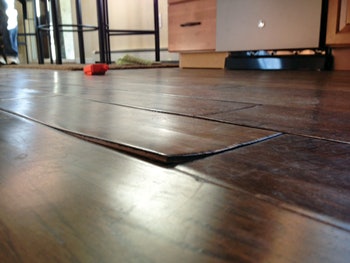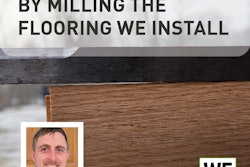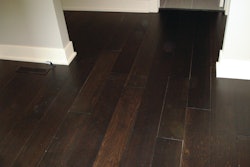


The Problem
I was called to inspect an engineered floor in Colorado that the homeowner said was "peeling and cracking."
The Procedure
The homeowner had bought the flooring from a local floor covering retailer and installed it himself in a house he was remodeling. The flooring was a 7-inch-wide, 1/2-inch-thick hand-scraped, prefinished engineered floor with a hickory wear layer, and he nailed down about 500 feet over a plywood subfloor on the first floor of the home, which had a basement. The house was not occupied while the remodeling was in progress. Only five to six weeks after installation, the floor began having problems.
The Cause
When I arrived on site, I could see areas where the flooring edges were curling up. There were cracks in the faces of some boards and white lines from finish checking in some areas; the floor just looked horrible. My hygrometer read 9.5%, and moisture meter readings taken throughout the wood floor registered between 4 and 6 MC, which is a range too low to get a reliable MC reading. While I was standing on the floor, there were three pops so loud they made me jump-it was three more boards coming apart.
RELATED: How to Prevent Wood Floor Gaps in Winter
The readings confirmed what I suspected-this engineered floor was suffering from low humidity levels and exhibiting what many people now refer to as "dry cupping." With our high altitude and low humidity levels here in Colorado, this problem is extremely common with engineered flooring, and it probably makes up about 80 percent of the inspections I do here. The low RH levels cause the fibers in the wear layer to dry first and begin to shrink. The core prevents the wear layer from shrinking and causes the wear layer to go into tension and the core into compression. If the wear layer dries too drastically (as it did in this instance), it is stressed beyond its elastic limit, which can cause a cupped appearance or, in severe cases, the wear layer to shear away from the core layer of the flooring. On this floor, what could be misconstrued as delamination was just the hickory wear layer shrinking.
How to Fix the Floor
The homeowner agreed to increase the humidity levels in the home. Once the humidity was corrected, there were about 25 boards that were permanently damaged and had to be replaced.
In the Future
Floor failures like this all come down to education at the point of sale. For this floor, the directions dictate that humidity levels be maintained between 30 and 50 RH, but, as we hear so often, the homeowner said, "They never told me that." When someone drives a Porsche off a lot, you know they'll follow the directions for maintaining that car. A hardwood floor should be no different, but we need salespeople to educate the homeowners up front before they buy that specific product.
People are sold on engineered flooring being the ultimate fix, but that just isn't true. Engineered products can be more stable, but you still have to follow the guidelines from the manufacturer, which aren't much different than they are for solid products. Some engineered products are manufactured to perform better in these climates. When I was a contractor, there were some products I simply would not install because I knew that in our area, it would be nearly impossible to keep the RH at an acceptable level for that product.

































